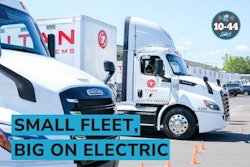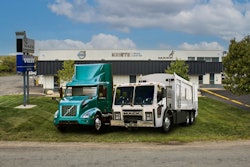
Beyond the benefit of zero emissions, total cost of ownership savings comes up a lot in marketing all-electric trucks and vans. OEMs have posted double-digit percentage gains over internal combustion, which are certainly appealing.
For Paul Rosa, senior vice president procurement and fleet planning at Penske Truck Leasing, such advertising is missing a critical factor: real world experience.
As an early adopter of all-electric equipment, which now includes hundreds of electric trucks and vans, Rosa said there’s still plenty to learn and that OEMs would be wise to reel in marketing efforts that attempt to nail down TCO gains.
“They put those percentage numbers out there and I wish they wouldn't, whether it be the OEMs or the startups, and I say that because it's just a big unknown,” Rosa said. “There is no other way to put it than it's a big unknown. And what I mean by that is unless an OEM or a startup has operated an electric vehicle in a very specific application for the normal first useful life, they can't say what the savings is going to be. You can speculate what it's going to be and that's what they've tried to do, but they have no empirical data that says, ‘If you run a medium duty truck 25,000 or 40,000 miles a year across six years, here's what the normal maintenance is and here's what the savings are going to be on an electric vehicle.”
The Penske Truck Leasing EV Evaluation Fleet includes the Freightliner eCascadia (Class 8), Freightliner eM2 (Class 6 and 7), Volvo VNR electric tractor (Class 8), International eMV (Class 6 and 7), Ford E-Transit (Class 2), Orange EV e-Triever electric terminal truck (Class 8 yard tractor), Freightliner Custom Chassis MT50e walk-in (Class 5 and 6), and XOS walk-in (Class 6).
A strong variety of electric trucks and vans helps reach more customers in more places which results in more data — something that Penske has been known to carefully consider through the years when determining vehicle efficiency. But the transition to zero-emission commercial vehicles has really only just begun, like the first few plays in the opening quarter of a football game Rosa said.
In addition to payload, topography and ambient temperatures, which vary from place to place, will have a greater impact on EV performance than internal combustion. Simply put: there haven’t been enough EVs in enough places over a long enough period of time to provide credible TCO figures.
“We don't understand all the applications over multiple years and until that happens, I don't think anyone can say that there's going to be any kind of savings until we actually experience it,” Rosa said.
Like what they’ve seen so far
In 2018, Penske and Daimler Trucks North America made headlines after Penske took delivery of DTNA’s first electric Freightliner eM2. Rosa looks back on that December day as a pivotal moment when Penske really immersed itself and “dove into this space jointly with Daimler.”The key to success has been pairing up EVs with applications that don’t push them beyond their capabilities.
“As the years went forward with more and more of the providers, whether they be startups or OEMs, the technology was able to prove that it can work,” Rosa said. “Now it can work in very specific applications and situations, but the good news was the technology could work. And I'm talking not just the truck itself. I'm talking about the communication with the charger to the vehicle and all that has to happen there. It was just good to see that it would work.”
Another plus has been the positive feedback from drivers.
‘The second major highlight is that the drivers embraced them,” Rosa said. “When they got in one they did not want to get out, and that was very positive because we were really worried [about driver acceptance]. But once they got into them, they just really embraced them and loved them and really didn't want to get out of them.”
Challenges along the way
New technology presents learning curves and that’s particularly true with all-new powertrains that have little in common with internal combustion.Challenges invariably arrise and accepting that premise with an open mind to learning makes a big difference.
“On the challenges side, I want qualify that by saying that it's okay to identify the challenges in a positive way,” Rosa said. “I don't want them to be perceived as a negative because you have to understand what you have to get over with new technology. And that's how we classify the challenges.”
It comes as little surprise that having a firm grasp on vehicle range proved to be a top priority.
"There have been some great learnings, several of them,” Rosa said. “If you go back over the last several years, the obvious ones that people are aware of today are range limitations. You restricted yourself to only a certain amount of applications and users because of the initial range you had.”
Other challenges have been the higher up-front cost of EVs, payload considerations and infrastructure entanglements that can be weighed down by permit applications and lengthy approval processes.
“The cost obviously was very high for understandable reasons,” Rosa said. “The cost per kilowatt battery is very high right now as well as the development cost of the technology. So the cost ends up being a big challenge. Weight was still a challenge as well for some applications. Configuration restrictions were also part of the challenges where you couldn't use them in all applications for the type of specification that you needed. And then of course, you get into the infrastructure challenges, the ability to get power, modifying your building, the process to get permits and everything.”
Rosa said uniform infrastructure policies that do not vary from place to place would be helpful.
“If you're going to have 12 different processes, 12 different applications, 12 different permitting, steps to take, it can be overwhelming for a company,” he said. “Having some uniformity, having some standardization, doing something to bring them closer together, streamlining them as well. If we're going to see adoption happen faster, we have to see some improvement in the utility company's processes. That's not a knock on them. They just weren't prepared for this tidal wave of activity.”
Rosa recommends staying up to date on zero-emission issues and to prepare accordingly.
“You have to have a vehicle plan, a facility plan, and an infrastructure or charging plan because they all go hand in hand,” he said. “And if you're not prepared with all of that, you're falling behind and you don't want fall behind because this is happening. It's inevitable.”













